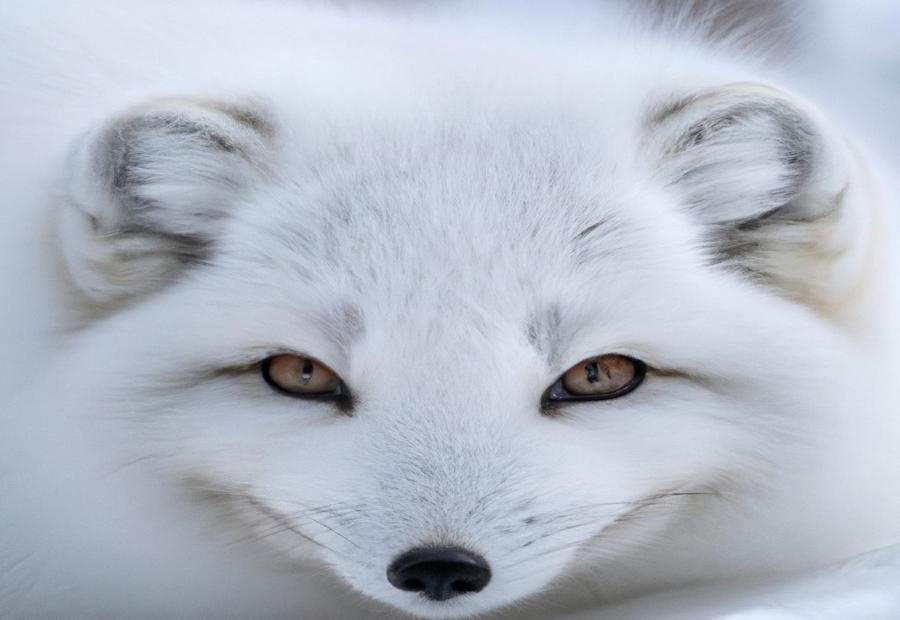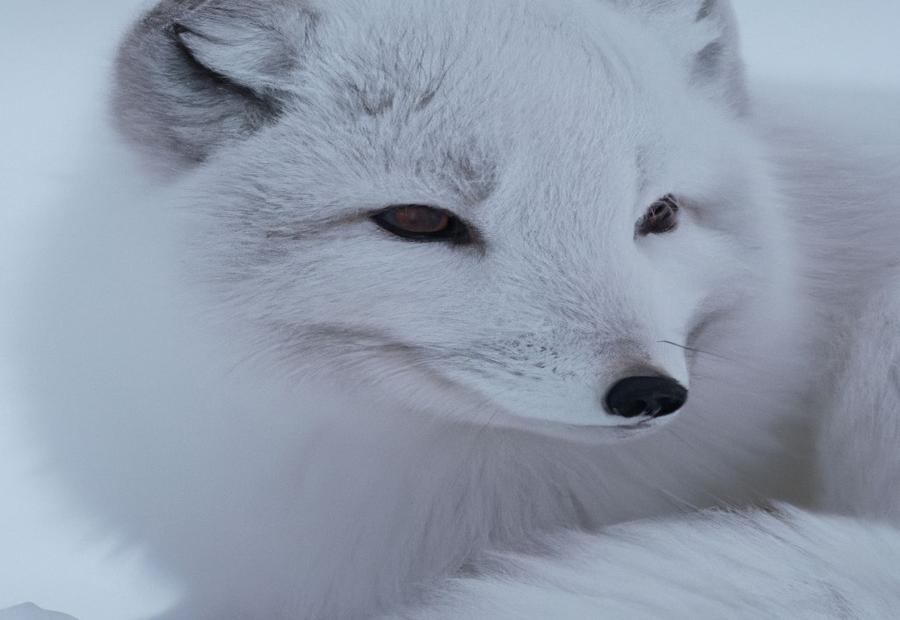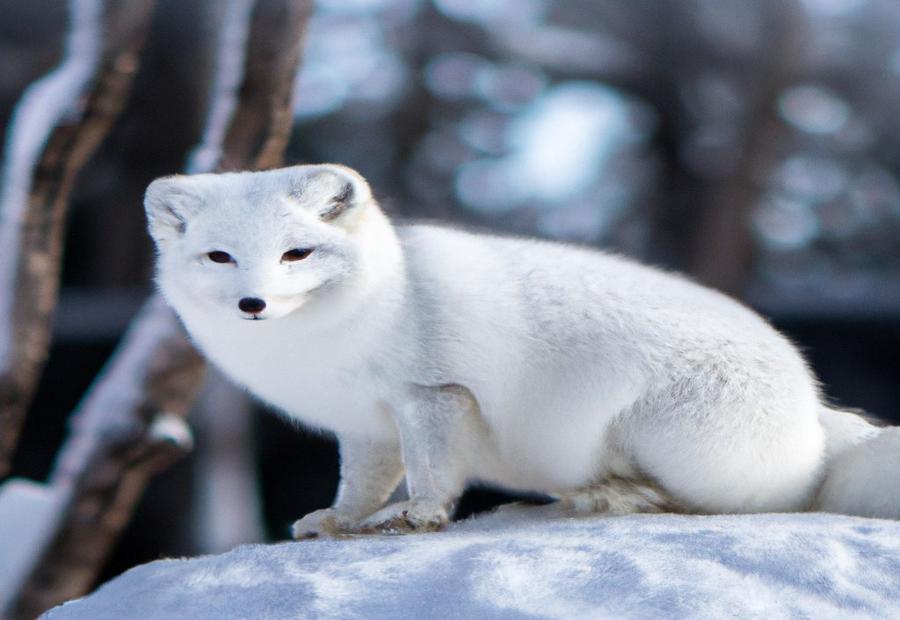Arctic foxes, also known as snow foxes or polar foxes, are fascinating creatures that have adapted to survive in the harsh Arctic environment. These small, resilient canines possess unique characteristics and behaviors that allow them to thrive in sub-zero temperatures. Let’s explore more about these incredible creatures and their habitat in this article.
Arctic foxes, scientifically known as Vulpes lagopus, are native to the Arctic regions of the Northern Hemisphere. They are a species of small-sized foxes, with a fluffy white coat during the winter, and a brownish-gray or blue-gray coat during the summer. These adaptable creatures are known for their resourcefulness and ability to survive in extreme cold conditions.
Arctic foxes have several distinct physical adaptations that help them thrive in their icy surroundings. They have a compact body with short legs, furry paws, and a bushy tail that aids in insulation. Their thick fur provides excellent insulation, keeping them warm in freezing temperatures. The color of their fur changes seasonally to blend in with their environment, providing camouflage and protection from predators.
Arctic foxes are native to the Arctic regions of North America, Greenland, Scandinavia, and Russia. They can be found in a variety of habitats, including tundra, coastal areas, and Arctic islands. These adaptable creatures can survive in diverse environments, ranging from frozen sea ice to mountainous regions.
Arctic foxes primarily live in the northern polar regions, including the Arctic Circle. They have a circumpolar distribution, meaning they are found in different regions around the Arctic. Their habitat choice depends on factors such as food availability, denning sites, and proximity to other Arctic animals.
Arctic foxes have evolved numerous adaptations to survive in the harsh Arctic environment. Their compact size and round body shape minimize heat loss and conserve body warmth. Their thick fur and furry paws provide insulation and traction on icy surfaces. They also have excellent hearing, sharp eyesight, and a keen sense of smell to detect prey and predators in their snowy surroundings.
As we delve deeper into the article, we will explore the diet, behavior, reproduction, conservation status, and fascinating facts about these remarkable Arctic foxes. Stay tuned to learn more about these incredible creatures and their remarkable survival skills.
Contents
Physical Characteristics of Arctic Foxes

Photo Credits: Foxauthority.Com by Eugene Harris
The physical characteristics of Arctic foxes are highly adapted to their environment. They have a size range of small to medium, measuring around 60 to 75 centimeters in length and weighing between 2.5 to 5 kilograms. Their most notable feature is their thick and dense double-layered coat, which is crucial for their survival in the cold Arctic climate. The outer layer consists of long guard hairs that provide insulation, while the inner layer is soft and dense, offering additional warmth.
Arctic foxes possess a unique coloration that changes with the seasons. During winter, their fur turns predominantly white, allowing them to camouflage perfectly in the snowy landscape. In the summer, their fur varies from grayish-brown to dark brown, blending seamlessly with their surroundings. These adaptations enable them to remain hidden from predators and increase their chances of survival.
In addition to their coat, Arctic foxes have physical adaptations that further aid their survival in the harsh Arctic environment. They have small ears and a short snout, minimizing heat loss from these areas. Furthermore, their bushy tail serves as a crucial appendage for keeping warm.
The Arctic fox also possesses specialized paw structure to navigate the icy habitat. Their footpads are covered with fur, providing insulation and preventing slipping on icy surfaces. This adaptation allows them to move confidently and efficiently in their environment.
Despite the challenging conditions, Arctic foxes are highly mobile creatures. They display impressive speed and agility, capable of traveling long distances. They can reach speeds of up to 50 kilometers per hour and are also skilled swimmers.
Overall, the physical characteristics of Arctic foxes, including their size, coat, coloration, adaptations, paw structure, and mobility, contribute to their ability to thrive in extreme weather conditions and survive in their unique Arctic habitat.
Habitat and Distribution

Photo Credits: Foxauthority.Com by Lawrence Flores
The Arctic fox is found in the Arctic tundra regions of the Northern Hemisphere, including Alaska, Canada, Greenland, Russia, and Scandinavia. They have adapted to survive in their cold and harsh habitat through their thick fur, compact body size, and a keen sense of hearing and smell. Due to their vast range and remote habitat, it is difficult to determine their exact population numbers. However, the Arctic fox is not endangered and is considered a species of “Least Concern” by the International Union for Conservation of Nature (IUCN).
One interesting fact about the Arctic fox is that they have highly seasonal coats. In winter, their fur is thick and pure white, providing excellent camouflage in the snow-covered landscape. In summer, their fur changes to a brown or grayish color, blending in with the rocky terrain and vegetation of their tundra habitat.
Where Do Arctic Foxes Live?
Arctic foxes live in the arctic regions specifically in the tundra biome of the northern hemisphere. They prefer treeless lands and areas covered in snow and ice, which provide the necessary resources for their survival and camouflage. These environments are where Arctic foxes establish their habitats.
Due to their adaptation to the frigid arctic temperatures and harsh conditions, Arctic foxes have evolved certain traits. For instance, they possess a thick white coat that aids in blending into their snowy surroundings, serving as a natural form of insulation against the cold. Additionally, their foot pads are furry, enabling them to navigate icy terrain with ease and maintain their core temperature. Such biological features allow them to thrive in their habitat.
Arctic foxes can be found in various locations near the North Pole and in regions across the Arctic Circle, including Alaska, Canada, Greenland, Russia, and Scandinavia. They also inhabit coastal areas, where they can access food sources such as small animals, ringed seal pups, and leftover scraps. Their ability to adapt to different ecosystems within the Arctic region contributes to their survival and success in these diverse environments.
Adaptations to the Arctic Environment
Arctic foxes possess impressive adaptations that allow them to thrive in the unforgiving Arctic environment. These adaptations encompass a dense fur coat that provides warmth, white fur for effective camouflage, and the use of underground dens for shelter and raising their young. For more information on what are arctic foxes, visit this reputable source.
These remarkable adaptations not only help Arctic foxes regulate their body temperature and effectively hunt for food, but also create secure spaces for rest and reproduction.
The survival of Arctic foxes heavily relies on these adaptations, which also play a pivotal role in their natural history. By comprehending and appreciating these adaptations, we develop a deeper admiration for the abilities of these small creatures in their unique environment.
It is essential to observe Arctic foxes without causing any disturbance, as this ensures the stability of their species and maintains the delicate balance of the Arctic ecosystem.
The exceptional adaptations of Arctic foxes are the outcome of thousands of years of evolution and deserve to be acknowledged and revered. Through learning about and valuing these adaptations, we can enhance our understanding and protection of the distinct and delicate Arctic environment where these foxes thrive.
Diet and Feeding Habits
Diet and Feeding Habits of Arctic Foxes
Arctic foxes have a diverse diet that depends on the availability of food. They eat whatever is abundant at the time. Their diet includes:
- Lemmings: During peak lemming population years, lemmings can make up to 90% of the Arctic fox’s diet.
- Small mammals: They also eat voles and hares when available.
- Birds: They feed on birds and their eggs, including seabirds and nesting birds.
- Carrion: Arctic foxes scavenge carcasses from larger predators.
Arctic foxes have developed adaptive feeding habits to survive in their harsh environment:
- Cache food: They can store excess food by burying it in the ground or snow for when food is scarce.
- Opportunistic hunting: They scavenge food from polar bear kills and other sources.
Arctic foxes are remarkable creatures that adapt their diet to survive in the challenging Arctic conditions. They utilize various food sources and have adapted behaviors to enhance their chances of finding nourishment. These adaptations have enabled Arctic foxes to thrive in an environment where resources can be scarce.
Behavior and Reproduction
When it comes to the behavior and reproduction of arctic foxes, there are fascinating sub-sections to explore. From their intricate social structure and communication dynamics to their unique reproductive and parental care strategies, these arctic creatures have evolved remarkable adaptations to thrive in their harsh environment. Get ready to dive into the captivating world of arctic fox behavior and reproduction, where we’ll uncover their secrets and shed light on their extraordinary survival strategies.
Social Structure and Communication
The social structure and communication of Arctic foxes can be understood through the following:
1. Social Organization: Arctic foxes have a monogamous social structure. They form pairs that mate for life, establishing stable family units and sharing responsibilities in raising their offspring. Related individuals sometimes cooperate and support each other.
2. Communication Methods: Arctic foxes use vocalizations and body language to communicate. They use barks, yips, and howls to convey messages like territorial warnings or mating calls. Body language, including postures and facial expressions, is important for social interactions or conflicts.
Reproduction and Parental Care
Reproduction and parental care in arctic foxes are incredibly intriguing. During the breeding season, arctic foxes engage in courtship rituals to find a suitable mate. Male foxes take the initiative to mark their territory, aiming to attract females who select their partners based on dominance and the quality of the territory.
Following successful mating, female arctic foxes assume the primary responsibility for parental care. They carefully choose a den where they give birth to a litter of 6 to 12 adorable pups.
Dedicated and nurturing, female arctic foxes offer constant care and protection to their young. They diligently nurse the pups and provide them warmth, utilizing their thick fur and body heat to maintain a stable core temperature in the frigid Arctic temperatures.
As the pups mature, their mother imparts crucial hunting and survival skills. Under her watchful eye, they gradually transition to a diet that includes solid food, with the mother first introducing them to prey she brings. The pups learn the art of hunting and scavenging, guided by their mother’s expertise.
Arctic foxes showcase remarkable family bonds, and both parents may contribute to the care of the pups. Nonetheless, it is the female arctic foxes who play a significant role in selecting the den, providing care, and nurturing the offspring.
Threats and Conservation

Photo Credits: Foxauthority.Com by Elijah Taylor
Arctic foxes face various threats and challenges in their environment, making their conservation an important endeavor. In this section, we will explore the dangers they encounter, such as natural predators and human impact. We will also delve into the ongoing efforts to protect and conserve these magnificent creatures. Get ready to uncover the realities these foxes confront and the steps being taken to ensure their survival in their delicate Arctic habitats.
Natural Predators
Arctic foxes face numerous natural predators in their Arctic habitat. These predators play a vital role in shaping the population dynamics and survival strategies of the foxes.
Polar bears, being one of the main predators of Arctic foxes, specifically target them as prey. They primarily hunt arctic foxes when food sources are scarce or when they come across fox dens.
Another group of predators that pose a threat to arctic foxes are certain bird species, such as snowy owls, that migrate to the Arctic. These birds have been observed hunting and preying on arctic foxes.
To defend themselves against these natural predators, arctic foxes have developed various strategies:
Firstly, they dig intricate dens in the snow, offering a secure hiding place. These dens have multiple entrances and chambers, making it challenging for predators to reach them.
Additionally, the white coat of arctic foxes serves as effective camouflage against the snowy landscape, making it more difficult for predators to spot them.
Understanding the dynamics between arctic foxes and their natural predators is critical for the conservation of the species and the overall balance of the Arctic ecosystem.
Human Impact and Conservation Efforts
Human impact and conservation efforts play a crucial role in the conservation of arctic foxes.
The arctic fox, scientifically known as Alopex lagopus, is a small and stout species that can be found in the arctic regions of the northern hemisphere.
These foxes have unique traits, such as winter camouflage and bluish brown fur, which enable them to survive in the frigid arctic temperatures and blend into snowy surroundings.
However, human activities pose significant threats to the population of arctic foxes. One major impact is habitat destruction caused by industrial development, which reduces available living space.
Additionally, climate change alters the habitat and prey availability, further affecting the traits and habits of red fox dens. In the past, hunting and trapping for fur have also had a significant impact on the population.
To address these threats and protect the arctic fox population, conservation efforts are being implemented. Currently classified as “least concern,” conservation measures primarily focus on preserving habitats and raising awareness about the importance of protecting these unique species.
Efforts are made to minimize habitat destruction and regulate hunting practices. For more information on exploring the presence and adaptation of red foxes in urban areas, you can discover everything you need to know about Arctic Foxes.
Understanding the impact of human activities and actively participating in conservation efforts are essential for ensuring the survival and well-being of arctic foxes for future generations.
It is crucial to continue monitoring and adapting conservation strategies to achieve a balance between human development and the preservation of these magnificent creatures.
A notable success story in conservation is the population recovery of the California condor. Through captive breeding programs and habitat restoration efforts, the California condor, which was once on the brink of extinction, has experienced significant population growth.
Thanks to the dedication of conservationists and wildlife agencies, there are now over 400 California condors in the wild.
However, ongoing conservation efforts are still necessary to ensure the long-term survival of this critically endangered species.
Interesting Facts about Arctic Foxes
Interesting Facts about Arctic Foxes
Arctic Foxes have adaptive fur that changes color with the seasons. In winter, their fur is white to blend with the snowy surroundings, while in summer, it turns brown or gray to match the tundra.
Arctic Foxes have excellent hearing to locate prey under thick snow. They also have specialized fur on their paws, acting like snowshoes, enabling them to walk on deep snow without sinking.
Arctic Foxes are resourceful hunters and can survive on a varied diet, including lemmings, voles, birds, eggs, berries, and carrion. They can locate prey from beneath the snowpack using their keen sense of hearing.
Arctic Foxes have multiple dens in their territory for shelter and raising their young. They may have up to 15 dens, including reused ones from previous generations.
During the breeding season, Arctic Foxes form monogamous pairs and both parents participate in raising their pups. The female gives birth to a litter of 5-8 pups, and they are well-cared for by both parents.
Arctic foxes can survive temperatures as low as -58 F (-50 C). They are found in regions near the Arctic Circle in North America, Europe, and Asia.
Frequently Asked Questions
What are Arctic foxes?
Arctic foxes, also known as polar foxes or snow foxes, are small mammals that belong to the Canidae family. They are native to the Arctic regions of the Northern Hemisphere and are well adapted to living in cold environments.
What are the physical characteristics of Arctic foxes?
Arctic foxes have a furry white body, dark eyes, and a furry tail that can reach up to 13.75 inches in length. They have stubby legs, short snouts, and curled ears that minimize heat loss. On average, they measure 18 to 26.75 inches in length and weigh between 6.5 and 17 pounds.
How do Arctic foxes survive in cold environments?
Arctic foxes have several adaptations that allow them to survive in cold environments. They have a thick coat of fur that provides insulation and serves as effective winter camouflage. They also have furry soles on their feet, which act as built-in snow boots, keeping their feet warm while navigating the icy terrain. Their dens, made within a snowy mound, provide additional protection from the cold.
What do Arctic foxes eat?
Arctic foxes are opportunistic feeders and have a varied diet. They primarily prey on small rodents called lemmings but also consume birds, insects, fish, berries, and even carrion. During harsh winters, they may scavenge leftover scraps from polar bear kills. Their diet can vary depending on food availability and seasonal changes.
How long do Arctic foxes live and reproduce?
In the wild, Arctic foxes have an average lifespan of 3 to 6 years. They reach sexual maturity in as little as 10 months. Breeding occurs during the spring, and the gestation period lasts about 52 days. Female Arctic foxes give birth to litters of up to 25 pups, but the average litter size is around 5 to 8 kits.
What are the threats to Arctic foxes?
Arctic foxes face several threats, including global warming, competition from other species like red foxes, and hunting and trapping for the fur trade. The shrinking habitat due to retreating ice and expanding forests is also a significant concern for the long-term survival of Arctic fox populations.